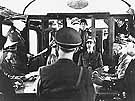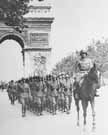
|
|
|

|

|

|

|
|
Click on an image to see a larger, more detailed picture.
|
|
|
|
|
| 1940: Machinery of Hatred |

|
pg. 197 |

|
|
|
|
| |
 General Wilhelm Keitel presents terms of surrender to French leaders on June 21, 1940. Hitler demanded that the meeting be held in the historic Armistice railcar, where Germany's surrender after WWI took place. Seated from left to right, starting with Joachim von Ribbentrop's back, are Hermann Göring, Hitler, Field Marshal Walter von Brautisch (facing camera), and Rudolf Hess (also facing camera). On the right are French generals Jean-Marie Joseph Bergeret (nearest camera) and Charles Léon Clément Huntziger.
General Wilhelm Keitel presents terms of surrender to French leaders on June 21, 1940. Hitler demanded that the meeting be held in the historic Armistice railcar, where Germany's surrender after WWI took place. Seated from left to right, starting with Joachim von Ribbentrop's back, are Hermann Göring, Hitler, Field Marshal Walter von Brautisch (facing camera), and Rudolf Hess (also facing camera). On the right are French generals Jean-Marie Joseph Bergeret (nearest camera) and Charles Léon Clément Huntziger.
Photo: UPI/Corbis-Bettmann
|
 Paris Occupation
Paris Occupation
As German troops marched into Paris on June 14, 1940, millions of Parisians fled southward. Loudspeaker trucks warned that aggression and sabotage were punishable by death, while propaganda broadcasts told Parisians that the Germans meant them no harm. However, for many of the 100,000-plus Parisian Jews, the Nazi occupation meant persecution and deportation to death camps. A census located all Jews in the city. A card index listed each Jew's address, occupation, and nationality. French identity cards were confiscated. Yellow Star armbands were ordered and nighttime curfews imposed. Assisted by Paris police, the SS conducted periodic roundups of Jews. Those found were sent to the Drancy, France, transit camp for deportation. A mammoth hunt in 1942 collected 13,000 Jews, including 4000 children--many of whom had been separated from their parents. After being penned up in a sports stadium for one week, the crying children were then crammed into cattle cars and delivered to Auschwitz.
|
 Celebrating their victory in France, German troops march down the Champs-Élysées through the Arc de Triomphe. The armistice signed in June divided France into two areas. One part was occupied by the Germans and placed under military control, while the other was indirectly controlled by the Germans through the government of Marshal Pétain. The latter was headquartered in Vichy in the south of France. Half of the roughly 350,000 Jews in France lived in Paris and were immediately threatened by the Nazis' occupation. The Vichy government, too, moved to segregate Jews from French society, promulgating the Statut des Juifs (Jewish Law), which conformed to the German Nuremberg Laws.
Celebrating their victory in France, German troops march down the Champs-Élysées through the Arc de Triomphe. The armistice signed in June divided France into two areas. One part was occupied by the Germans and placed under military control, while the other was indirectly controlled by the Germans through the government of Marshal Pétain. The latter was headquartered in Vichy in the south of France. Half of the roughly 350,000 Jews in France lived in Paris and were immediately threatened by the Nazis' occupation. The Vichy government, too, moved to segregate Jews from French society, promulgating the Statut des Juifs (Jewish Law), which conformed to the German Nuremberg Laws.
Photo: Wide World Photo / United States Holocaust Memorial Museum Photo Archive
|
|

|

|

|

|
 June 4, 1940: The concentration camp at Neuengamme, Germany, is upgraded to primary-camp status.
June 4, 1940: The concentration camp at Neuengamme, Germany, is upgraded to primary-camp status.
|
 June 4, 1940: French and British troops are evacuated from Dunkerque, France.
June 4, 1940: French and British troops are evacuated from Dunkerque, France.
|
 June 10, 1940: Italy announces that it has entered the war, as a junior ally to Germany.
June 10, 1940: Italy announces that it has entered the war, as a junior ally to Germany.
|
 June 14, 1940: The first inmates, including teachers, priests, and other non-Jewish Poles, arrive at the Auschwitz death camp.
June 14, 1940: The first inmates, including teachers, priests, and other non-Jewish Poles, arrive at the Auschwitz death camp.
|
 June 14, 1940: Paris falls to the Germans. Noted novelist and German-Jewish refugee Ernst Weiss commits suicide in the city.
June 14, 1940: Paris falls to the Germans. Noted novelist and German-Jewish refugee Ernst Weiss commits suicide in the city.
|
 June 16, 1940: France presses for an armistice with Germany.
June 16, 1940: France presses for an armistice with Germany.
|
 June 21, 1940: American radio correspondent William L. Shirer broadcasts details of France's capitulation to Germany.
June 21, 1940: American radio correspondent William L. Shirer broadcasts details of France's capitulation to Germany.
|
 June 22, 1940: France surrenders and signs an armistice with Germany.
June 22, 1940: France surrenders and signs an armistice with Germany.
|
 June 26, 1940: United States Assistant Secretary of State Breckinridge Long determines to obstruct the granting of visas to Jews seeking entry into the United States. He seeks indefinitely to "delay and effectively stop" such immigration by ordering American consuls "to put every obstacle in the way [to] postpone and postpone and postpone the granting of visas." His goal will be realized over the next four years.
June 26, 1940: United States Assistant Secretary of State Breckinridge Long determines to obstruct the granting of visas to Jews seeking entry into the United States. He seeks indefinitely to "delay and effectively stop" such immigration by ordering American consuls "to put every obstacle in the way [to] postpone and postpone and postpone the granting of visas." His goal will be realized over the next four years.
|
|
|
|
|
| 1940: Machinery of Hatred |

|
pg. 197 |

|
|
The Holocaust Chronicle
© 2009 Publications International, Ltd.
|
|
